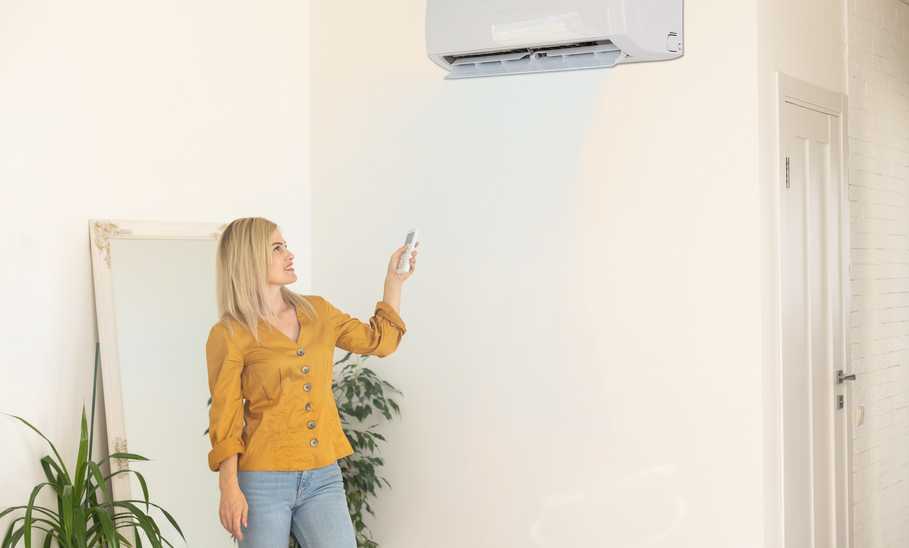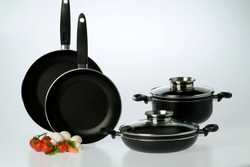- 10-year warranty
- Designed for longevity
- Built-in dirt blocking filter
The Best Air Conditioners Brands to Reliably Keep Your Home Cool

Our evaluations and opinions are not influenced by our advertising relationships, but we may earn a commission from our partners’ links. This content is created by TIME Stamped, under TIME’s direction and produced in accordance with TIME’s editorial guidelines and overseen by TIME’s editorial staff. Learn more about it.
Summer is only a few months away and that means it’s time to start preparing for the warm weather. You may already have a ceiling fan, but if you live in a particularly warm state, having an air conditioner is essential. As someone who lives in Florida, I don’t know what I’d do without my air conditioner on the days when it hits the upper 90s.
Luckily, my apartment is equipped with central cooling, however, that’s not the case for every home. If that sounds like the case, then you’re probably in the market for an air conditioner. You may head to Lowe’s or The Home Depot to find an air conditioner, but with so many to choose from it can be overwhelming. I’ve rounded up the best air conditioner brands you’ll want to check out for a bedroom or shared living space.
If you’re in the market for a high-quality and durable air conditioner, Goodman has you covered. Not only is the brand known for having some of the best warranties in the business, but also unbeatable prices for its air conditioners before installation. In terms of energy efficiency, Goodman products have SEER ratings up to 24.5 which is significantly above average and uses a R-410A refrigerant which is less harmful to the environment than many refrigerants.
Live in an area with extremely high and low temperatures? A Coleman HVAC can keep you comfortable year round. The sleek, compact and cost-effective air conditioners are more energy efficient than most and have decent smart capabilities for optimal functioning. Plus, the noise levels are pretty low, so they won’t rattle an entire room while in operation—ideal for families with young children and pets.
You might be familiar with Frigidaire for your refrigerator needs, however, the brand is also home to a variety of window air conditioners, built-in, and portable air conditioners. You’ll find Wi-Fi-enabled options and numerous settings to explore including multi-fan speed, sleep mode, a programmable timer, and an automatic restart.
Black+Decker boasts popular home appliances from vacuums to air conditioners. The brand's air conditioners are perfect for a standard home. With an assortment of window and portable air conditioners, you’ll find options for numerous rooms whether it’s a small dorm room or larger living room. Many units have energy-efficient features to save money and help the environment, and small wheels to make it easy to move when necessary.
GE is another popular household brand that has affordable, high-quality options. Large and small spaces can benefit from GE’s air conditioners that offer various cooling and fan modes, 10 temperature settings, and easy to clean filters. Plus it’s quiet, so there are no annoying rumbles and whistles while in operation.
Whirlpool has an assortment of portable and window air conditioning units for customers with different spaces and budgets. Most units feature an electronic control panel with various cooling speeds, modes (eco and sleep), and timers. Window-mounted air conditioners come with an installation kit, so you can do it yourself. It’s easy to care for and even notifies you when the filter is ready to be cleaned.
For a hotel-like air conditioning experience, opt for Amana with its assortment of smart home options and standard units. A majority of their units have a high SEER rating with scores reaching up to 24.5, so you can feel comfortable knowing you’re helping take care of the environment while remaining comfortable. While some of the brand’s air conditioners can be expensive, they do offer financing options to make payment more manageable for customers.
Whether you’re looking for an air conditioner that’s under $200 or a more high-tech AC/heating system, Midea has you covered. The brand has dozens of units with an extensive range of BTU’s for different sized spaces, three fan speeds, and an intuitive temperature adjustment panel. Midea has solid options for owners looking into quiet air conditioners whether they have tiny kids or take work meetings from home.
Can be difficult to assemble
Give Honeywell a go if you’re in the market for both an air conditioner and dehumidifier. Whether it’s for those stuffy basements or bedrooms, you’ll receive consistent cooling benefits and dehumidifying with its built-in drain. Also, if you need to move the portable unit, the caster wheels make it easy to glide across the floor without having to pick it up.
American Standard is home to a variety of air conditioners that have undergone rigorous testing to ensure durability in the harshest weather conditions and environments. While units have a high price tag, you’ll get the most out of your purchase with numerous speeds, a wide network of contractors for easy installation, and smart options to fit the modern day tech-savvy home.
Choose an air conditioner with a variety of cooling settings and fan speeds. Some air conditioners have a wider range of temperatures, so you’ll want to check each unit prior to purchase. That said, the cooling capabilities can be impacted by the filter, so you’ll want to make sure it’s easy to clean to keep it in tip top shape.
When looking for an air conditioner, some features you’ll want to keep in mind are whether it’s technologically advanced—think remote controls, Wi-Fi connectivity, etc. Also, for those concerned about the environment, see if there are eco-friendly options available. Many brands have automatic shut-off options or energy-saver modes to help with this. You’ll also want to note whether or not it has a removable filter to clean. If the air conditioner is difficult to clean, that can make it a hassle to maintain. For a portable air conditioner, make sure it has casters so it can easily be wheeled from place to place without strain.
In the most basic terms, an energy-efficient air conditioning system will deliver substantially more cooling output than the power required to fuel that output. According to Katie Davis, Trane Residential’s VP of Engineering and Technology, there are four factors you’ll want to consider when thinking about energy efficiency—compressors, coils, airflow, and dynamic load management.
Compressors work by “compressing” the refrigerant throughout the vapor compression cycle, providing a way to move heat. “The more efficient a compressor is at doing its job, the more efficient a system will be, says Davis.” Most of the power utilized by an HVAC system is directly related to the compressor.”
As for coils, air blows across them to achieve the desired temperature. According to Davis, an HVAC manufacturer’s coil design determines how efficient and effective a system is at transferring heat.
In terms of airflow, the more efficient the fan and blower motor are at moving air across the coil, the higher the system efficiency. “Motors with variable speeds offer the best efficiency,” Davis adds.
Last but not least, dynamic load management involves how the system changes throughout the day. “HVAC systems that effectively manage these frequent changes provide the most efficient solution to homeowners when it comes to heating and cooling,” says Davis.
Also, keep an eye out for the Seasonal Energy Efficient Ratio (SEER) rating. This indicates an AC’s cooling output divided by the energy it uses in watt-hours. A SEER rating above 13 is generally considered good, the average rating is 16, and anything above 20 is high quality.
Newer air conditioner models are generally more energy efficient than their older counterparts. You’ll want to keep an eye out for an Energy Star certification, which means the air conditioner meets the energy efficiency guidelines from the U.S. Environmental Protection Agency. Energy Star units must have a SEER rating of 14.5 or higher and can help you save money and help protect the environment.
An HVAC system typically lasts a minimum of 10 years. “Homeowners can extend the system’s life beyond 10 years with regular preventive maintenance, usually performed twice a year,” says Davis. “Maintenance contracts are available through most HVAC contractors, and they are a great way to keep your HVAC system in tip-top shape.”
The cost of central air conditioning varies based on the output. In general, central air conditioners are more cost-effective than window air conditioners, however, this depends on how long it is turned on. In terms of installation, the cost to install central air is usually in the thousands whereas a window air conditioner is a couple hundred dollars. Air conditioning can get expensive but you can save money by using energy-efficient settings and maximizing blackout curtains and ceiling fans for extra airflow so you reduce the need for constant use.
To find the best air conditioners, I researched the different brands on the market and analyzed several based on user experience and customer reviews. My list includes different brands well suited for different budgets, spaces, and energy preferences.
The best brand is the one that suits your individual needs. For example, if you’re looking for an affordable air conditioner, check out Coleman or Goodman. For a more energy-efficient option, Trane has a high SEER rating and so does Lennox.
The best air conditioner is one that suits your individual home and preferences. Davis says that there are some key questions you want to consider when purchasing a new HVAC system. For example, how dynamic is the load in the home? Are there a lot of people entering and exiting the home during the day, or is it more stable? What do you consider comfortable from a temperature and humidity perspective? Are the occupants of the home hot-natured or cold-natured? Do you use most of the space in the home or are there spaces that are frequently vacant?
“The answers to these questions can help determine whether to select a fixed- or variable-speed system, and they let the HVAC dealer better understand the specific homeowner’s specific needs and preferences,” says Davis.
Most HVAC manufacturers provide online resources for finding dealers. For example, Trane Residential has an easy online search tool that identifies specialists by zip code. You’ll want to check with each individual brand to see what the options are for regular installation and emergencies.
There are a few characteristics to keep in mind when determining which size air conditioner you need. “Load calculations will consider the home’s square footage, regional climate data, and occupants’ habits to properly size the equipment to meet the needs of the home and the homeowner,” says Davis.
Both Trane and Carrier have standout features, so one isn’t necessarily better than the other but they are different. For example, Carrier has a slightly higher SEER rating whereas Trane’s noise levels are about 10 decibels lower. Both Trane and Carrier have options for manual control and digital control through a mobile application. Trane has a slightly longer warranty than Carrier, so that could be a deciding factor too.
The type of air conditioner that’s most energy efficient is one that has a high SEER rating and also takes into consideration compressors, coils, airflow, and dynamic load management. Many options from American Standard are energy efficient, but you’ll find a variety of picks from different brands too. At a basic level, central air conditioning is usually more energy efficient than a window unit.
The information presented here is created by TIME Stamped and overseen by TIME editorial staff. To learn more, see our About Us page.



